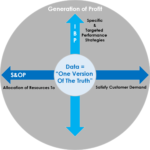Recently I was listening to and interview on Bloomberg Business with Eric Schmidt, Executive Chairman of Google, and Civis Analytics CEO, Dan Wagner. They were talking about the power of big data and analytics. The interview was entitled “Why Data Analytics Is the Future of Everything”.
Their message was very clear. Coupling effective analytics with big data can change everything from the creation of corporate strategies to the way that people vote!
This is certainly a hot topic in the Supply Chain industry. In a recent benchmark study done by SupplyChainDigest™, 88.3% of the company participants said that the potential value that they could derive from analytics was a good or outstanding opportunity. However, 63.9% of the same participants noted their analytical capabilities were very basic or not advanced. Only 10.7% felt that their analytical capabilities had moved to an advanced level.
So what is holding back companies in developing the capabilities to actually realize significant value from analytics and big data? It boils down to the same three cornerstones or building blocks of every effective solution; the People involved, the Processes they follow and the Technology selected to enable the solution. Therefore this posting is the first of three. Today we will address People.
Let’s start with the top of the organization, the Executives. Every Executive makes decisions based on the best information available at the time they must decide, even when they know the information is lacking or incomplete. Every Executive would say that they value meaningful and actionable insights that could help formulate and lend support to corporate strategies. Strategies that help drive higher profits and / or gain market share. However, here are a few questions:
- Are they willing to be a first mover within their company to invest in the effort for advanced analytics (see earlier Change Agent blog) or are they waiting for others to take this initial step?
- Are they communicating their support to the organization so that everyone knows that creating effective analytics is a high long-term priority for the business?
- Finally, are they creating ways for the organization to celebrate the ongoing success that is being realized through this investment?
Let me share a story from the time when I was the President of CAPS Logistics. CAPS was on the forefront of creating supply chain optimization solutions and served over 16% of the Fortune 500. We were finalizing a deal with a large corporation for a national deployment of routing and scheduling software.
The CFO of a potential client organization and I were in my office finalizing a deal and the deployment plans. During the conversation, the CFO stated that he had a particular deployment approach that he wanted to use. I listened carefully and certainly wanted to make him happy and to close the deal. However, I knew this approach would not work and diplomatically told him so. Needless to say, he was not happy and said it was either his way or no deal.
Normally, one does everything they can do to satisfy the customer but in this case I could not justify his substantial investment in a plan doomed for failure. The CFO left my office with no deal being finalized. The next morning, I received a call from him asking that we meet again. Later, he shared that he respected the fact that we were so confident about the right way to do this and that he wanted to follow our plan. That result lead to 5 national deployments of the software and he became the most active executive in our customer base to find clever ways to communicate to the entire organization the strategic value of this effort. The CFO was a barrier to the organization’s success, but it was good that the CFO caved in and broke through the barrier.
People issues extend beyond the Executives. What about the people that are actually performing the analytical activities? In many cases, the most meaningful results from the application of analytics will be gained if the analysis is done by Business Users not Data Scientists (see earlier blog on business users not data scientists). To ensure that maximum value is derived from your analytics and big data initiatives, your Business Users need to:
- Have a good working knowledge of the business in order to recognize opportunities that are uncovered through new insights on customers, products or channel performance.
- Have received the proper training on how to integrate analytics into their problem solving skills versus self-taught, hands on training
- Have confidence that the data they are using is valid so that they remain on point in answering specific questions and solving prioritized problems versus having the distraction of defending their analysis to the data nay-sayers.
- Be open to working with their cross-functional counterparts to involve them in the analysis and to share analytical results to take advantage of enterprise based tactics and strategies versus “siloed” decisions.
Politics, cultural norms and / or just the reality of different personalities can also pose issues as you advance your organization’s capabilities to drive profit improvements through the use of advanced analytics. The key is to find ways to work through any of these issues in order to obtain a “win” for the organization that helps build excitement, buy in and momentum. Eric Schmidt firmly believes that coupling effective analytics with big data will change everything. If you believe in the wisdom that has driven Google’s success, these changes will lead to organizational wins that demonstrate financial performance improvements and that solidify the organization’s commitment to analytics and big data.
Everyone likes to be on a winning Team. If your people issues are addressed, you will be better positioned to continue to build financial success stories using analytics and big data.
I would love to hear your thoughts.
All the best,
Richard






